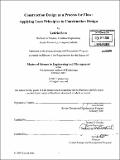| dc.contributor.advisor | Donna H. Rhodes. | en_US |
| dc.contributor.author | Soto, Leticia, S.M. Massachusetts Institute of Technology | en_US |
| dc.contributor.other | System Design and Management Program. | en_US |
| dc.date.accessioned | 2008-11-07T18:49:51Z | |
| dc.date.available | 2008-11-07T18:49:51Z | |
| dc.date.copyright | 2007 | en_US |
| dc.date.issued | 2007 | en_US |
| dc.identifier.uri | http://hdl.handle.net/1721.1/42995 | |
| dc.description | Thesis (S.M.)--Massachusetts Institute of Technology, System Design and Management Program, 2007. | en_US |
| dc.description | Includes bibliographical references (p. 108-111). | en_US |
| dc.description.abstract | Delays and cost overruns are the rule rather than the exception in the construction industry. Design changes due to lack of constructability late in the construction phase generating costly ripple effect which create delay and disruption throughout the entire organization, are the largest contributors to the stated rule. In the building construction industry, of increased competitiveness, demand from many companies continued effort to develop new methods and tools, in which the design for quality, cost, construability and reliability play an important role. The planning and management of building design has historically focused upon traditional methods of planning such as Critical Path Method (CPM). Little effort is made to understand the complexities of the design process; instead design managers focus on allocating work packages where the planned output is a set of deliverables. This current design method forces design teams to manage their work on a discipline basis, each working on achieving their deliverable as dictated by the design program with little regard of the relationship with other disciplines and organizations. In addition, because Architect and Engineering firms view design and construction as two separate independent phases of work in project it makes it difficult to verify constructability in a design and create flow in the overall process. The goal of this study is to look at how aligning interests, objectives and practices based on lean fundamentals, during the earliest stages of a project, as a method of improving construction performance. | en_US |
| dc.description.statementofresponsibility | by Leticia Soto. | en_US |
| dc.format.extent | 111 p. | en_US |
| dc.language.iso | eng | en_US |
| dc.publisher | Massachusetts Institute of Technology | en_US |
| dc.rights | M.I.T. theses are protected by
copyright. They may be viewed from this source for any purpose, but
reproduction or distribution in any format is prohibited without written
permission. See provided URL for inquiries about permission. | en_US |
| dc.rights.uri | http://dspace.mit.edu/handle/1721.1/7582 | en_US |
| dc.subject | System Design and Management Program. | en_US |
| dc.title | Construction design as a process for flow : applying lean principles to construction design | en_US |
| dc.type | Thesis | en_US |
| dc.description.degree | S.M. | en_US |
| dc.contributor.department | System Design and Management Program. | en_US |
| dc.identifier.oclc | 234428244 | en_US |
